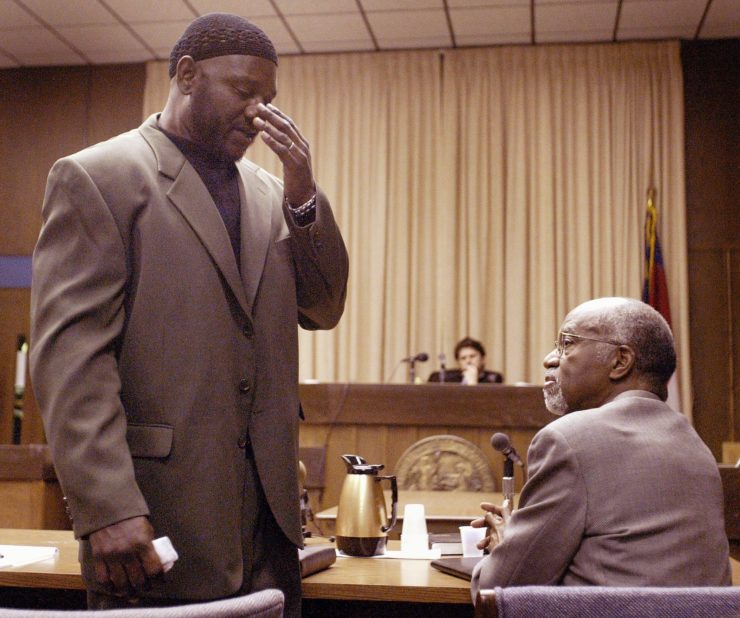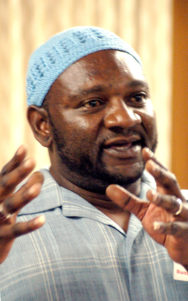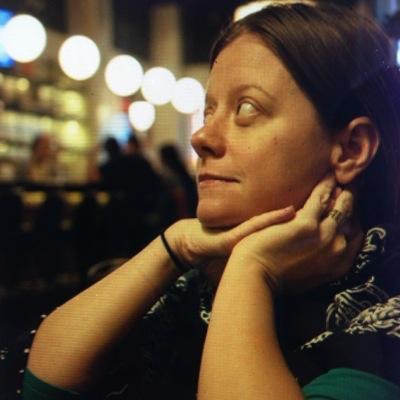
Darryl Hunt wipes his face as he addresses the family of Deborah Sykes after being freed in 2004 after serving 18 years for Sykes' killing,
On her first weekend at The Winston-Salem Journal in 1987, Phoebe Zerwick’s new coworkers took her to a famous crime scene: the place where a man named Darryl Hunt had allegedly raped and murdered a woman three years earlier. If that seems odd, it wasn’t for this North Carolina community. Winston-Salem had been consumed by the crime and Hunt’s trial.
“So that was a remarkable moment: telling something in a different way that would get readers involved.”
Zerwick couldn’t have imagined then that her reporting in the decades to come would not only change Hunt’s life irrevocably, it would change some of her fundamental journalistic assumptions and values.
In 2003, Zerwick began reporting about Hunt, a local man who had been convicted of raping and murdering Deborah Sykes, a woman who worked as a copy editor at the now-defunct Winston-Salem Sentinel. Zerwick’s editor at The Journal had assigned her a basic news article about Hunt’s request for DNA testing. But the article, informed by a tip from a reader, led to a series about Hunt and the Sykes case, and to Hunt’s exoneration and freedom.
But life in the free world was hard for Hunt, who had spent 19 years imprisoned on the false convictions. Zerwick, who remained in touch with Hunt over the years, saw him again in January 2016, when he came to talk to her class at Wake Forest University, where she is an associate professor and director of the school’s journalism program.
It was then that Zerwick realized that for all her reporting about Hunt, she’d never told his story. She was keen to correct that. But then, on March 13, 2016, Hunt was found dead inside a pickup truck. The medical examiner ruled Hunt’s death a suicide by self-inflicted gunshot wound.
Zerwick’s interest in Hunt’s story was stirred up again by his death. She decided to report the unfinished story, which was published on The Atavist platform earlier this month. The piece has been controversial, because Zerwick revealed Hunt’s apparent drug use and his lies about having cancer. But she believes those details help us understand the painful realities of Hunt’s life after being wrongfully accused.
“The stories we told shaped Hunt’s life,” she wrote. “Convicted him. Set him free. Made him a champion of justice. But his death seemed to be telling us that these narratives missed something. They didn’t exactly lie, but they weren’t the entire truth either,” she continued. “That’s the trouble with storytelling.”
“This,” she added, “is my attempt to get the story straight.”
I spoke with Zerwick by phone about her years spent reporting about Hunt, about what it means to tell someone else’s story, and what journalists can learn from her experiences covering Hunt’s life and death. The interview has been edited for length and flow.
In advance of our interview, I posted on Facebook (where else?!) that I was reading your Atavist article again in preparation for our conversation. Small world that it is, a friend mentioned that she had you and Darryl talk to a class she was teaching. Long story short, she was taken aback by your Atavist piece, wondering why Darryl can’t just rest in peace. Another friend expressed gratitude for the Atavist story, saying that she hadn’t heard Darryl’s story before and she thought the piece was important for the sake of documenting a life and not letting Darryl’s death be in vain. That’s a heavy place for us to start, but I think it’s an important one, too. How would you respond to these competing reactions?
I suppose part of it was intentional and part of it wasn’t so intentional, but I think, right after he died, I just got curious about what happened and started asking questions, because that’s what I know how to do. As I got more into it, I just felt that it got more intriguing and of course it was so sad, and I don’t know if this makes any sense, but I thought, the only thing I can do, the only thing I know how to do, is look into it and report on it and see if there’s a story for me to write. I suppose it felt like a duty or obligation.
The way I had ended up writing the piece was starting off in my classroom. I remembered seeing him in my classroom just a few weeks before he died, being struck by the fact that I had focused all that energy on investigating his case and then I’d been in touch with him on and off over the years, but I’d never really sat down and talked with him about how his life was like now and these bigger questions of whether he’d ever received justice. I had it in the back of my head that that would be something worthwhile to do. And then he died and the two ideas came together.
Can you talk about the original story, how you found out about him, and how that story unfolded?
I heard about his case my first weekend in North Carolina; a couple of reporters gave me a tour of Winston-Salem and took me to all the highlights, to show me places that I would need to know about as a reporter there. And the first place they took me to was the scene for the Deborah Sykes crime.
As far as getting into that investigative piece, our newsroom had been covering this story since the beginning, so by 2003, it was nearly 20 years. There was a new law on the books in North Carolina that allowed a defendant to ask for DNA testing if they had a claim of innocence, and Darryl, through his attorney, Mark Rabil, filed that motion. My boss, who was the metro editor, Les Gura, I saw him go up to [the newspaper’s] morgue and bring down the whole clips files. We had all these clippings in manila envelopes and we started going through them for this little news story he’d asked me for about Hunt’s request for DNA testing. And then Les Gura said to me, “Wow we should really take a fresh look at it.” At first, I thought, “Oh no, what have I done? I’ve got this huge assignment and how am I going to do it?” I was dreading it a little bit to some extent, because I didn’t see what I was going to be able to uncover in a case that had been covered so extensively already.
The stories we told shaped Hunt’s life. Convicted him. Set him free. Made him a champion of justice. But his death seemed to be telling us that these narratives missed something. They didn’t exactly lie, but they weren’t the entire truth either. That’s the trouble with storytelling. This is my attempt to get the story straight.”
But I went through it fairly methodically, I read everything, I interviewed everybody I could find, and when it came time to write it, what was so daunting about it was that I hadn’t really found any brand-new piece of evidence. We didn’t have the smoking gun. But we decided to tell it as a narrative as opposed to the way the evidence had always been presented. What we ended up with – which was new – was a new way of telling and looking at evidence that had largely already been examined. When we told the story as a narrative, it became way clearer that the case against Darryl Hunt just did not hold up.
And then what happened was, the series started on a Sunday, big circulation day, and that Monday this woman called me and she said, “I’m so glad you wrote that because I’ve known for 20 years that he didn’t do it.” And I said, “What do you mean?” And she said, “My daughter-in-law – and you can’t tell her I called — was raped six months after that crime and the police never let her pursue charges against the man she identified, and I’m sure it was the same person who killed Deborah Sykes.” That found its way into the last day of the series. And what did that do? When the state finally got around to doing the DNA testing that Darryl Hunt had asked for, it kind of put local law enforcement on notice that at least the newspaper and the public now knew about this other rape, and it turned out that the woman who called me was right. The man who had been identified by her daughter-in-law as the man who raped her ended up being matched to the Sykes crime.
So that was a remarkable moment: telling something in a different way that would get readers involved. This woman who called me had believed this for 20 years and had never thought to call the newspaper before, and because of the way the piece was written, local officials saw the case in a new way. The style of the writing was new.
That’s really fascinating and really moving and sad because it feels like the information that could have led to Hunt’s exoneration was there all along and all it took was simply – though I know there was nothing simple about it – to change the narrative, to make it narrative.
In a way, it is as simple as changing the narrative. I now work with Mark Rabil [Hunt’s lawyer], who’s on the faculty at Wake Forest Law School, and we’ve talked about this a great deal. We’ve given a talk about this at a law conference that has to do with narrative, and we’re giving another talk about it this summer. The way evidence is presented in court is so constrained by rules of evidence. Everyone is presented by the defense or the prosecutor, and then the other side tears that person apart and it goes one witness at a time. But life doesn’t unfold one witness at a time. So the way a courtroom narrative is constructed doesn’t get the facts out as well or as truthfully as the way a narrative is constructed and organized by time as opposed to character. So I think to some extent it is as simple as telling the narrative in a different way. And the way newspaper stories generally unfold is “he said, she said”; that’s the typical way of covering crimes and courts, and that’s how everybody’s done it since the beginning of time. But that also masks the truth, with a small “t”: The prosecutors in this case were wrong. And if you give both sides equal weight, it masks what the real story was.
That realization is powerful in a lot of ways. It’s powerful on a big-picture level in terms of potentially reshaping how you approach your work as a journalist, but it’s also really powerful on this individual level because it resulted in the exoneration of an innocent man. I’m wondering what kind of feelings that brought up for you. It seems that’s something to be celebrated, but I wonder whether there was a burden, too.
I didn’t feel it like a burden, but I also did feel some sense of responsibility when it was clear that things hadn’t [turned out well for Hunt]. I don’t think our original series got it wrong, but rather the narrative we’d all constructed—the narratives we construct about all these cases of wrongful conviction: He gets out, everybody’s ecstatic, the journalists get prizes, the filmmakers win awards, and everything is big and great and happy.
It hit me when he came to my classroom and he was telling stories that were so sad and tragic, that I had never really told his story, the story of this man. I had told the story of the case. There was something that was very serious that was going on with him that I hadn’t delved into. And so I suppose when he died, I felt that that was a little bit of a burden or a responsibility. But also, the truth is, I was curious; I wanted to find out.
You’re right, it’s not isolated; there are so many examples of “happy ending” exoneration narratives, but it’s way more complicated. There’s trauma. A society left you behind and doesn’t know how to help you reintegrate. I’m wondering, with this piece on The Atavist platform, if you’re hoping that it does anything in terms of, not contesting that narrative necessarily, but complicating it.

Darryl Hunt speaks before a House committee in Raleigh, N.C., in 2005 regarding a proposed execution moratorium in the state.,
Absolutely. So going back to your first question, about the woman who asked, “Why bother? Why not just let him rest in peace?” I think it’s a more than fair question and it’s something I kept wrestling with, except I think that, yes, stories always draw people in in a way that discussing something in the abstract doesn’t. There’s plenty of research about life after exoneration. Probably not enough, but there is a body of research. There are studies based on interviews that pretty much tell us what Darryl Hunt’s life story tells us: that life after exoneration is really, really hard; many people suffer from drug/alcohol addiction, psychiatric disorders, problems with their relationships, financial problems — all these things you’d expect if you’d had your life taken from you for many years. It’s all interesting and compelling to think about, but people are more often drawn into one person’s story, so yes, I hope that people read it and it opens their eyes to the fact that exoneration alone doesn’t bring about justice.
The other thing I think the piece is relevant for is this whole question of mass incarceration. The trauma Darryl suffered in prison, millions of people are suffering. Most of them are guilty of crimes, but there are a lot of people in this country whose lives are being destroyed in the same way Darryl Hunt’s life was destroyed. At last count I think there were 2,003 known cases of exoneration; that’s a lot of people who were wrongly convicted, imprisoned, and who face the same challenges Darryl faced. And there are probably many more because it’s usually only the big cases that get attention for someone to get exonerated.
I think this is a story that could be told about many people. The moral question, whether it’s the right thing to do, I think it’s a fair question. I don’t know that I know the answer to that.
What lessons can journalists take away from your experiences working on these stories about Darryl Hunt, especially with respect to interrogating ourselves and asking what it means to tell someone else’s story?
The big thing I learned was the whole question of transparency. When I started in journalism, we all talked about objectivity and neutrality. And then I started teaching journalism and a lot of people don’t talk about objectivity as much anymore as about transparency. So I suppose when I was writing this, I felt — I’m not that comfortable writing in the first person, but I felt it was really important because I’m guided by “The Elements of Journalism” that lays out the principles of journalism. I believe in those principles: that we want to be independent, that facts need to be verified, that we speak on behalf of citizens. So this question of transparency is something all of us need to be thinking about.
I have kind of rethought the whole first-person thing, and I thought in this case it added a tremendous amount to the piece, but I also think I could haven’t written it if it wasn’t in the first person. I wasn’t completely independent, I wasn’t completely neutral. Making your biases transparent now feels more important to me than trying to be unbiased. I don’t think every piece needs to be first person – you’d never get anything done. But there are some stories where that works and it’s important, and I suppose that would be a lesson for journalists to draw out of this.
The second thing is what we already know: that things are never what they seem on the surface, so we need to remember that.
Also, nothing replaces calling people you think aren’t going to want to talk to you. Getting out of the office and talking to people … all of those basic lessons.
I suppose the other thing, getting back to the first person, I did something with this that I would have been reluctant to do when I was younger. I was sharing my conclusions with some of the people I interviewed, so it was more a conversation. When I was younger, subjects would ask, “Well, what are you going to say?” And I’d say, “That’s not the point; I’m reporting what other people say.”
The basics still hold: Triple, quadruple check everything. And talk to people. All kinds of people.


